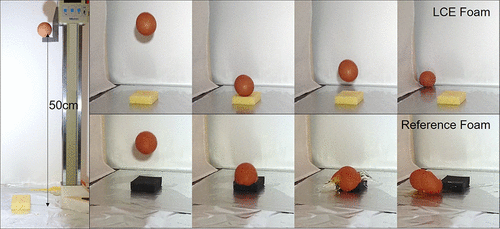当前位置:
X-MOL 学术
›
ACS Appl. Mater. Interfaces
›
论文详情
Our official English website, www.x-mol.net, welcomes your
feedback! (Note: you will need to create a separate account there.)
3D Printing of Liquid Crystal Elastomer Foams for Enhanced Energy Dissipation Under Mechanical Insult
ACS Applied Materials & Interfaces ( IF 8.3 ) Pub Date : 2020-12-28 , DOI: 10.1021/acsami.0c17538 Chaoqian Luo 1 , Christopher Chung 1 , Nicholas A. Traugutt 1 , Christopher M. Yakacki 1 , Kevin N. Long 2 , Kai Yu 1
ACS Applied Materials & Interfaces ( IF 8.3 ) Pub Date : 2020-12-28 , DOI: 10.1021/acsami.0c17538 Chaoqian Luo 1 , Christopher Chung 1 , Nicholas A. Traugutt 1 , Christopher M. Yakacki 1 , Kevin N. Long 2 , Kai Yu 1
Affiliation

|
Polymer foams are an essential class of lightweight materials used to protect assets against mechanical insults, such as shock and vibration. Two features are important to enhance their energy absorption characteristics: the foam structure and the matrix phase mechanical behavior. This study investigates novel approaches to control both of these features to enhance the energy absorption capability of flexible lattice foams. First, we consider 3D printing via digital light processing (DLP) as a method to control the foam mesostructure across a suite of periodic unit cells. Second, we introduce an additional energy dissipation mechanism in the solid matrix phase material by 3D printing the lattice foams with polydomain liquid crystal elastomer (LCE), which undergo a mechanically induced phase transition under large strains. This phase transition is associated with LC mesogen rotation and alignment and provides a second mechanism for mechanical energy dissipation in addition to the viscoelastic relaxation of the polymer network. We contrast the 3D printed LCE lattices with conventional, thermomechanically near-equivalent elastomer lattice foams to quantify the energy-absorbing enhancement the LCE matrix phase provides. Under cyclic quasi-static uniaxial compression conditions, the LCE lattices show dramatically enhanced energy dissipation in uniaxial compression compared to the non-LCE equivalent foams printed with a commercially available photocurable elastomer resin. The lattice geometry also plays a prominent role in determining the energy dissipation ratio between the LCE and non-LCE foams. We show that when increasing the lattice connectivity, the foam deformation transitions from bending-dominated to stretching-dominated deformations, which generates higher axial strains in the struts and higher energy dissipation in the lattice foam, as stretching allows greater mesogen rotation than bending. The LCE foams demonstrate superior energy absorption during the repeated dynamic loading during drop testing compared with the non-LCE equivalent foams, demonstrating the potential of LCEs to enhance physical protection systems against mechanical impact.
中文翻译:

液晶弹性体泡沫的3D打印以增强机械损伤下的能量耗散
聚合物泡沫是一类重要的轻质材料,用于保护资产免受机械冲击,例如冲击和振动。有两个功能对提高其能量吸收特性很重要:泡沫结构和基体相的机械性能。这项研究研究了控制这两个功能以增强柔性晶格泡沫的能量吸收能力的新颖方法。首先,我们将通过数字光处理(DLP)进行的3D打印视为控制整个周期单位单元中泡沫介观结构的一种方法。其次,我们通过用多畴液晶弹性体(LCE)3D打印晶格泡沫,在固相材料中引入了一种附加的能量耗散机理,该多畴液晶弹性体在大应变下经历了机械诱导的相变。该相变与LC液晶元的旋转和排列有关,并且除了聚合物网络的粘弹性松弛之外,还提供了用于机械能耗散的第二种机理。我们将3D打印的LCE晶格与常规的热机械近等弹性体晶格泡沫进行对比,以量化LCE基质相提供的能量吸收增强。在循环准静态单轴压缩条件下,与使用市售可光固化弹性体树脂印刷的非LCE等效泡沫相比,LCE晶格在单轴压缩中显示出显着增强的能量耗散。晶格几何形状在确定LCE和非LCE泡沫之间的能量耗散率方面也起着重要作用。我们表明,当增加晶格连通性时,泡沫的变形从弯曲为主的变形过渡到拉伸为主的变形,这会在支杆中产生更高的轴向应变,并在晶格泡沫中产生更高的能量耗散,因为拉伸比弯曲允许更大的介晶旋转。与非LCE等效泡沫相比,LCE泡沫在跌落测试过程中的反复动态载荷过程中表现出优异的能量吸收能力,这表明LCE具有增强物理保护系统抵抗机械冲击的潜力。
更新日期:2020-12-28
中文翻译:

液晶弹性体泡沫的3D打印以增强机械损伤下的能量耗散
聚合物泡沫是一类重要的轻质材料,用于保护资产免受机械冲击,例如冲击和振动。有两个功能对提高其能量吸收特性很重要:泡沫结构和基体相的机械性能。这项研究研究了控制这两个功能以增强柔性晶格泡沫的能量吸收能力的新颖方法。首先,我们将通过数字光处理(DLP)进行的3D打印视为控制整个周期单位单元中泡沫介观结构的一种方法。其次,我们通过用多畴液晶弹性体(LCE)3D打印晶格泡沫,在固相材料中引入了一种附加的能量耗散机理,该多畴液晶弹性体在大应变下经历了机械诱导的相变。该相变与LC液晶元的旋转和排列有关,并且除了聚合物网络的粘弹性松弛之外,还提供了用于机械能耗散的第二种机理。我们将3D打印的LCE晶格与常规的热机械近等弹性体晶格泡沫进行对比,以量化LCE基质相提供的能量吸收增强。在循环准静态单轴压缩条件下,与使用市售可光固化弹性体树脂印刷的非LCE等效泡沫相比,LCE晶格在单轴压缩中显示出显着增强的能量耗散。晶格几何形状在确定LCE和非LCE泡沫之间的能量耗散率方面也起着重要作用。我们表明,当增加晶格连通性时,泡沫的变形从弯曲为主的变形过渡到拉伸为主的变形,这会在支杆中产生更高的轴向应变,并在晶格泡沫中产生更高的能量耗散,因为拉伸比弯曲允许更大的介晶旋转。与非LCE等效泡沫相比,LCE泡沫在跌落测试过程中的反复动态载荷过程中表现出优异的能量吸收能力,这表明LCE具有增强物理保护系统抵抗机械冲击的潜力。


















































 京公网安备 11010802027423号
京公网安备 11010802027423号